Boeing 777
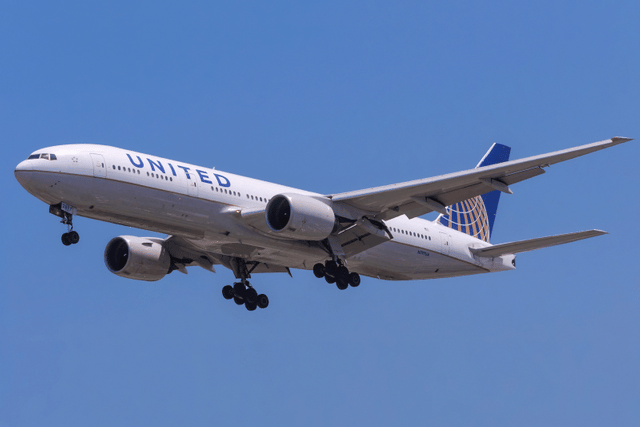
Boeing 777

| Boeing 777 | |
|---|---|
| A Boeing 777-200ER of United Airlines, the launch customer of the 777 | |
| Role | Wide-body jet airliner |
| National origin | United States |
| Manufacturer | Boeing Commercial Airplanes |
| First flight | June 12, 1994 |
| Introduction | June 7, 1995, with United Airlines |
| Status | In service |
| Primary users | Emirates United Airlines Cathay Pacific Air France |
| Produced | 1993–present |
| Number built | 1,609 through August 2019[12] and deliveries[13] |
| Program cost | US$5 billion[14] |
| Unit cost | (US$ million, 2019) -200ER: 306.6, -200LR: 346.9, -300ER: 375.5, 777F: 352.3[15] |
| Developed into | Boeing 777X |
The Boeing 777 (Triple Seven) is a long-range wide-body twin-engine jet airliner developed and manufactured by Boeing Commercial Airplanes. It is the world's largest twinjet and has a typical seating capacity of 314 to 396 passengers, with a range of 5,240 to 8,555 nautical miles (9,704 to 15,844 km). Commonly referred to as the "Triple Seven",[16][17] its distinguishing features include large-diameter turbofan engines, long raked wings, six wheels on each main landing gear, fully circular fuselage cross-section,[18] and a blade-shaped tail cone.[19] Developed in consultation with eight major airlines, the 777 was designed to replace older wide-body airliners and bridge the capacity difference between Boeing's 767 and 747. As Boeing's first fly-by-wire airliner, it has computer-mediated controls. It was also the first commercial aircraft to be designed entirely with computer-aided design.
The 777 is produced in two fuselage lengths as of 2018. The original 777-200 variant entered commercial service in 1995, followed by the extended-range 777-200ER in 1997. The stretched 777-300, which is 33.25 ft (10.1 m) longer, followed in 1998. The initial 777-200, extended-range -200ER, and -300 versions are equipped with General Electric GE90, Pratt & Whitney PW4000, or Rolls-Royce Trent 800 engines. They have since been collectively referred to as 777 Classics.[20] The extended-range 777-300ER and ultra long-range 777-200LR variants entered service in 2004 and 2006 respectively, while the 777F, a freighter version, debuted in February 2009; these second-generation variants all feature high-output GE90 engines and extended raked wingtips. The 777-200LR is one of the world's longest-range airliners, able to fly more than halfway around the globe and holds the record for the longest distance flown non-stop by a commercial aircraft.[21][22] In November 2013, Boeing announced the development of the third-generation of the 777, the 777X, consisting of the 777-8 and 777-9 variants. The 777X features composite wings with folding wingtips and General Electric GE9X engines plus further technologies developed for the Boeing 787 Dreamliner, and is scheduled to enter service by 2020.
The 777 first entered commercial service with United Airlines on June 7, 1995. The 777 has received more orders than any other wide-body airliner; as of July 2019, more than 60 customers had placed orders for 2,045 aircraft of all variants, with 1,606 delivered.[12] The most common and successful variant is the 777-300ER[23] with 809 delivered and 844 orders;[12] Emirates operates the largest 777 fleet, with 163 passenger and freighter aircraft as of July 2018.[24] The sixth 777 hull loss occurred in October 2016; the Asiana Airlines Flight 214 accident in July 2013 was its first fatal crash in 18 years of service, and the shootdown of Malaysia Airlines Flight 17 in July 2014 is its deadliest crash as of January 2019.
The 777 ranks as one of Boeing's best-selling models; by 2018 it had become the most-produced Boeing wide-body jet, surpassing the Boeing 747.[25] Airlines have acquired the type as a comparatively fuel-efficient alternative to other wide-body jets and have increasingly deployed the aircraft on long-haul transoceanic routes. Direct market competitors include the Airbus A330-300, the Airbus A350 XWB, and the out-of-production A340 and McDonnell Douglas MD-11. The Boeing 787 Dreamliner, which entered service in 2011, shares some design features with the new 777X models.
| Boeing 777 | |
|---|---|
| A Boeing 777-200ER of United Airlines, the launch customer of the 777 | |
| Role | Wide-body jet airliner |
| National origin | United States |
| Manufacturer | Boeing Commercial Airplanes |
| First flight | June 12, 1994 |
| Introduction | June 7, 1995, with United Airlines |
| Status | In service |
| Primary users | Emirates United Airlines Cathay Pacific Air France |
| Produced | 1993–present |
| Number built | 1,609 through August 2019[12] and deliveries[13] |
| Program cost | US$5 billion[14] |
| Unit cost | (US$ million, 2019) -200ER: 306.6, -200LR: 346.9, -300ER: 375.5, 777F: 352.3[15] |
| Developed into | Boeing 777X |
Development
Background
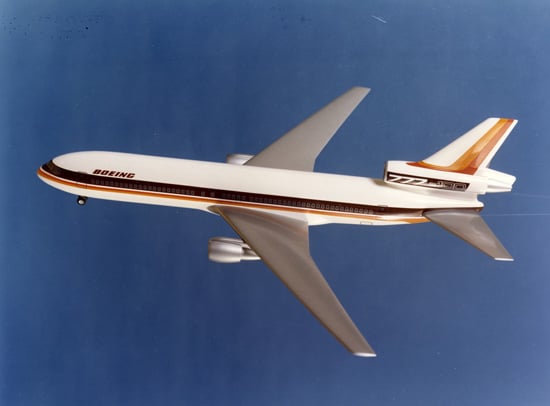
The Boeing 777-100 trijet concept
In the early 1970s, the Boeing 747, McDonnell Douglas DC-10, and the Lockheed L-1011 TriStar became the first generation of wide-body passenger airliners to enter service.[26] In 1978, Boeing unveiled three new models: the twin-engine Boeing 757 to replace its 727, the twin-engine 767 to challenge the Airbus A300, and a trijet 777 concept to compete with the DC-10 and L-1011.[27][28][29] The mid-size 757 and 767 launched to market success, due in part to 1980s' extended-range twin-engine operational performance standards (ETOPS) regulations governing transoceanic twinjet operations.[30] These regulations allowed twin-engine airliners to make ocean crossings at up to three hours' distance from emergency diversionary airports.[31] Under ETOPS rules, airlines began operating the 767 on long-distance overseas routes that did not require the capacity of larger airliners.[30] The trijet 777 was later dropped, following marketing studies that favored the 757 and 767 variants.[32] Boeing was left with a size and range gap in its product line between the 767-300ER and the 747-400.[33]
By the late 1980s, DC-10 and L-1011 models were approaching retirement age, prompting manufacturers to develop replacement designs.[34] McDonnell Douglas was working on the MD-11, a stretched and upgraded successor of the DC-10,[34] while Airbus was developing its A330 and A340 series.[34] In 1986, Boeing unveiled proposals for an enlarged 767, tentatively named 767-X,[35] to target the replacement market for first-generation wide-bodies such as the DC-10,[31] and to complement existing 767 and 747 models in the company lineup.[36] The initial proposal featured a longer fuselage and larger wings than the existing 767,[35] along with winglets.[37] Later plans expanded the fuselage cross-section but retained the existing 767 flight deck, nose, and other elements.[35]
Airline customers were uninterested in the 767-X proposals, and instead wanted an even wider fuselage cross-section, fully flexible interior configurations, short- to intercontinental-range capability, and an operating cost lower than that of any 767 stretch.[31] Airline planners' requirements for larger aircraft had become increasingly specific, adding to the heightened competition among aircraft manufacturers.[34] By 1988, Boeing realized that the only answer was a new clean-sheet design, which became the 777 twin-jet.[38] The company opted for the twin-engine configuration given past design successes, projected engine developments, and reduced-cost benefits.[39] On December 8, 1989, Boeing began issuing offers to airlines for the 777.[35]
Design effort
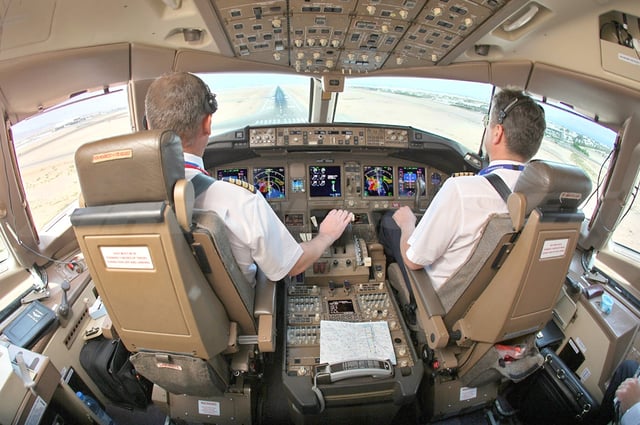
The two-crew glass cockpit has fly-by-wire controls
Alan Mulally served as the Boeing 777 program's director of engineering, and then was promoted in September 1992 to lead it as vice-president and general manager.[40][41] The design phase for the new twinjet was different from Boeing's previous commercial jetliners. For the first time, eight major airlines – All Nippon Airways, American Airlines, British Airways, Cathay Pacific, Delta Air Lines, Japan Airlines, Qantas, and United Airlines – had a role in the development.[42] This was a departure from industry practice, where manufacturers typically designed aircraft with minimal customer input.[43] The eight airlines that contributed to the design process became known within Boeing as the "Working Together" group.[42] At the first group meeting in January 1990, a 23-page questionnaire was distributed to the airlines, asking what each wanted in the design.[31] By March 1990, Boeing and the airlines had decided upon a basic design configuration: a cabin cross-section close to the 747's, capacity up to 325 passengers, flexible interiors, a glass cockpit, fly-by-wire controls, and 10 percent better seat-mile costs than the A330 and MD-11.[31] Boeing selected its Everett factory in Washington, home of 747 production, as the 777's final assembly site.[44]
On October 14, 1990, United Airlines became the 777's launch customer when it placed an order for 34 Pratt & Whitney-powered aircraft valued at US$11 billion with options on an additional 34.[45][46] The development phase coincided with United's replacement program for its aging DC-10s.[47] United required that the new aircraft be capable of flying three different routes: Chicago to Hawaii, Chicago to Europe, and non-stop from Denver, a hot and high airport, to Hawaii.[47] ETOPS certification was also a priority for United,[48] given the overwater portion of United's Hawaii routes.[45] In January 1993, a team of United developers joined other airline teams and Boeing designers at the Everett factory.[49] The 240 design teams, with up to 40 members each, addressed almost 1,500 design issues with individual aircraft components.[50] The fuselage diameter was increased to suit Cathay Pacific, the baseline model grew longer for All Nippon Airways, and British Airways' input led to added built-in testing and interior flexibility,[31] along with higher operating weight options.[51]
The 777 was the first commercial aircraft designed entirely by computer.[36][45][52] Each design drawing was created on a three-dimensional CAD software system known as CATIA, sourced from Dassault Systemes and IBM.[53] This lets engineers assemble a virtual aircraft, in simulation, to check for interference and verify that the thousands of parts fit properly—thus reducing costly rework.[54] Boeing developed its own high-performance visualization system, FlyThru, later called IVT (Integrated Visualization Tool) to support large-scale collaborative engineering design reviews, production illustrations, and other uses of the CAD data outside of engineering.[55] Boeing was initially not convinced of CATIA's abilities and built a physical mock-up of the nose section to verify its results. The test was so successful that additional mock-ups were canceled.[56] In fact, the 777 "was completed with such precision that it was the first Boeing jet that didn’t need its kinks worked out on an expensive physical mock-up plane", which contrasted sharply with the development of Boeing's next new airliner, the 787. [57]
Into production and testing
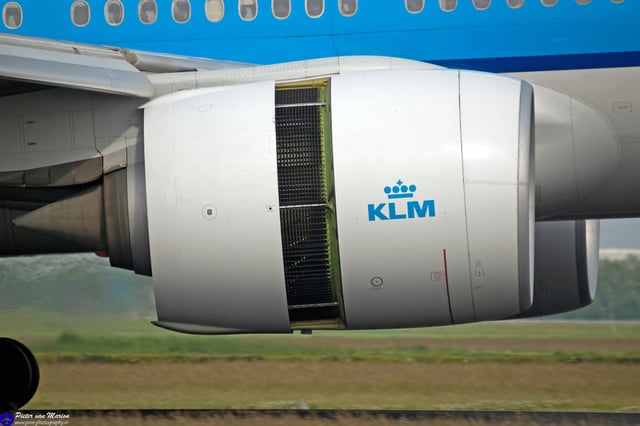
General Electric GE90 with its thrust reverser deployed
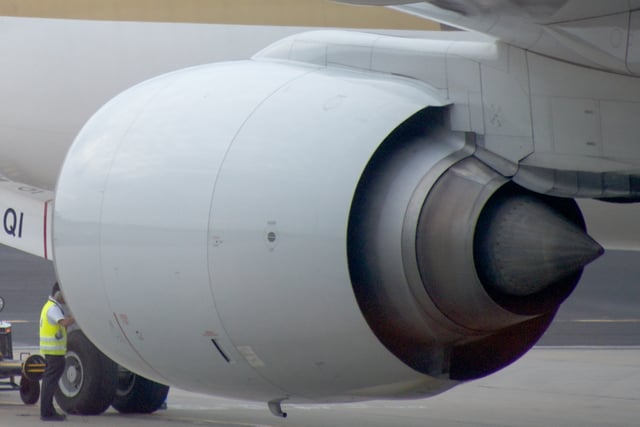
Rolls-Royce Trent 800
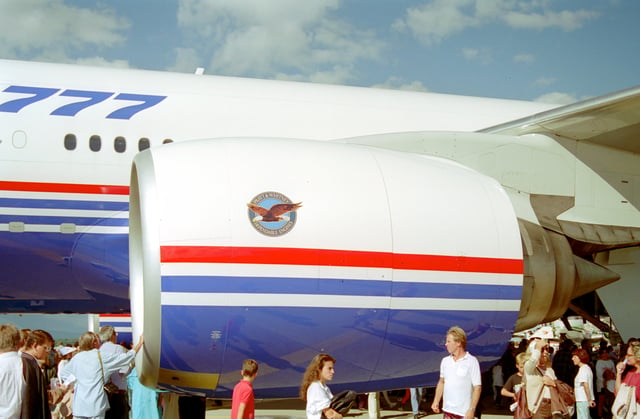
Pratt & Whitney PW4000
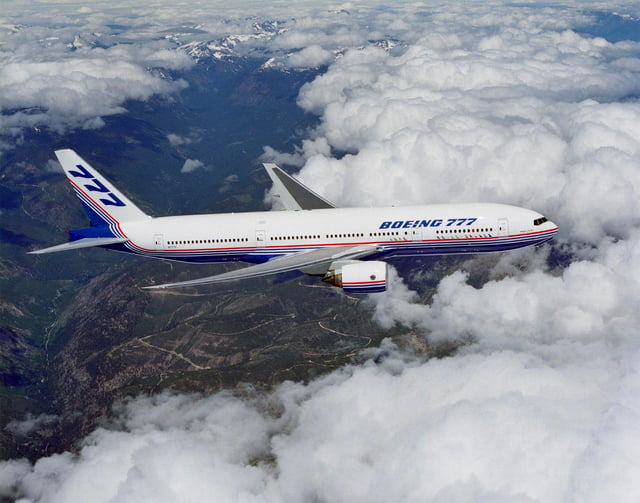
The 777 made its maiden flight on June 12, 1994
The production process included substantial international content, an unprecedented level of global subcontracting for a Boeing jetliner,[58] later exceeded by the 787.[59] International contributors included Mitsubishi Heavy Industries and Kawasaki Heavy Industries (fuselage panels),[60] Fuji Heavy Industries, Ltd. (center wing section),[60] Hawker de Havilland (elevators), and Aerospace Technologies of Australia (rudder).[61] An agreement between Boeing and the Japan Aircraft Development Corporation, representing Japanese aerospace contractors, made the latter risk-sharing partners for 20 percent of the entire development program.[58] The initial 777-200 model was launched with propulsion options from three manufacturers, General Electric, Pratt & Whitney, and Rolls-Royce,[62] giving the airlines their choice of engines from competing firms.[63] Each manufacturer agreed to develop an engine in the 77,000 lbf (340 kN) and higher thrust class (a measure of jet engine output) for the world's largest twinjet.[62]
To accommodate production of its new airliner, Boeing doubled the size of the Everett factory at the cost of nearly US$1.5 billion[45] to provide space for two new assembly lines.[47] New production methodologies were developed, including a turn machine that could rotate fuselage subassemblies 180 degrees, giving workers access to upper body sections.[53] Major assembly of the first aircraft began on January 4, 1993.[64] By the start of production, the program had amassed 118 firm orders, with options for 95 more from 10 airlines.[65] Total investment in the program was estimated at over US$4 billion from Boeing, with an additional US$2 billion from suppliers.[66]
On April 9, 1994, the first 777, line number WA001, was rolled out in a series of 15 ceremonies held during the day to accommodate the 100,000 invited guests.[67] The first flight took place on June 12, 1994,[68] under the command of chief test pilot John E. Cashman.[69] This marked the start of an 11-month flight test program that was more extensive than testing for any previous Boeing model.[70] Nine aircraft fitted with General Electric, Pratt & Whitney, and Rolls-Royce engines[68] were flight tested at locations ranging from the desert airfield at Edwards Air Force Base in California[71] to frigid conditions in Alaska, mainly Fairbanks International Airport.[72] To satisfy ETOPS requirements, eight 180-minute single-engine test flights were performed.[73] The first aircraft built was used by Boeing's nondestructive testing campaign from 1994 to 1996, and provided data for the -200ER and -300 programs.[74] At the successful conclusion of flight testing, the 777 was awarded simultaneous airworthiness certification by the U.S. Federal Aviation Administration (FAA) and European Joint Aviation Authorities (JAA) on April 19, 1995.[68]
Entry into service
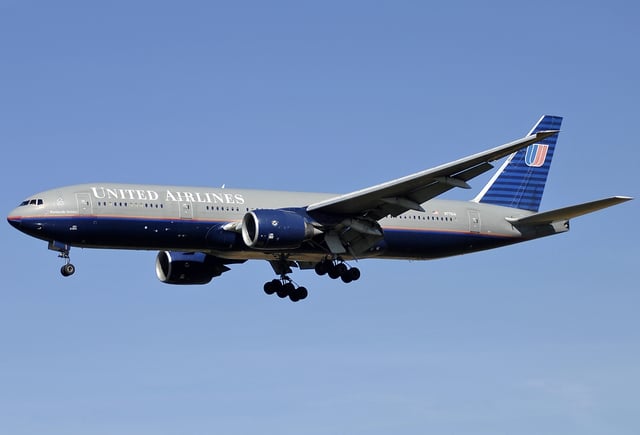
on May 15, 1995, United Airlines received the first 777-200 and made the first commercial flight on June 7
Boeing delivered the first 777 to United Airlines on May 15, 1995.[75][76] The FAA awarded 180-minute ETOPS clearance ("ETOPS-180") for the Pratt & Whitney PW4084-engined aircraft on May 30, 1995, making it the first airliner to carry an ETOPS-180 rating at its entry into service.[77] The first commercial flight took place on June 7, 1995, from London Heathrow Airport to Dulles International Airport near Washington, D.C.[78] Longer ETOPS clearance of 207 minutes was approved in October 1996.[79]
On November 12, 1995, Boeing delivered the first model with General Electric GE90-77B engines to British Airways,[80] which entered service five days later.[81] Initial service was affected by gearbox bearing wear issues, which caused British Airways to temporarily withdraw its 777 fleet from transatlantic service in 1997,[81] returning to full service later that year.[71] General Electric subsequently announced engine upgrades.[71]
The first Rolls-Royce Trent 877-powered aircraft was delivered to Thai Airways International on March 31, 1996,[80] completing the introduction of the three powerplants initially developed for the airliner.[82] Each engine-aircraft combination had secured ETOPS-180 certification from the point of entry into service.[83] By June 1997, orders for the 777 numbered 323 from 25 airlines, including satisfied launch customers that had ordered additional aircraft.[68] Operations performance data established the consistent capabilities of the twinjet over long-haul transoceanic routes, leading to additional sales.[84] By 1998, the 777 fleet had approached 900,000 flight hours.[85] Boeing states that the 777 fleet has a dispatch reliability (rate of departure from the gate with no more than 15 minutes delay due to technical issues) above 99 percent.[86][87][88][89]
Initial derivatives
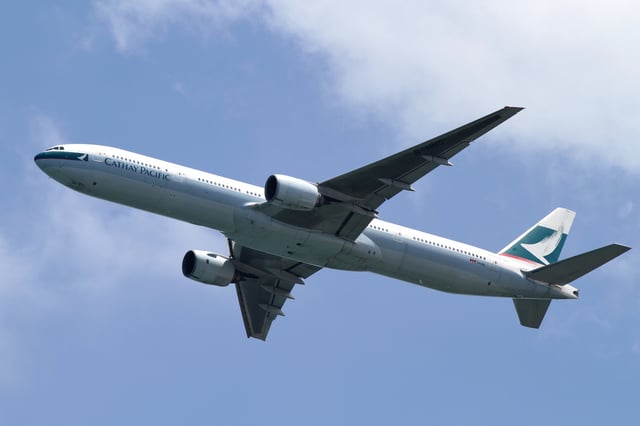
Cathay Pacific introduced the stretched 777-300 on May 27, 1998
After the original model, Boeing developed an increased gross weight variant of the 777-200 with greater range and payload capability.[90] Initially named 777-200IGW,[91] the 777-200ER first flew on October 7, 1996,[92] received FAA and JAA certification on January 17, 1997,[93] and entered service with British Airways on February 9, 1997.[93] Offering greater long-haul performance, the variant became the most widely ordered version of the aircraft through the early 2000s.[90] On April 2, 1997, a Malaysia Airlines -200ER named "Super Ranger" broke the great circle "distance without landing" record for an airliner by flying eastward from Boeing Field, Seattle to Kuala Lumpur, a distance of 10,823 nautical miles (20,044 km; 12,455 mi), in 21 hours and 23 minutes.[85]
Following the introduction of the -200ER, Boeing turned its attention to a stretched version of the airliner. On October 16, 1997, the 777-300 made its first flight.[92] At 242.4 ft (73.9 m) in length, the -300 became the longest airliner yet produced (until the A340-600), and had a 20 percent greater overall capacity than the standard length model.[94] The -300 was awarded type certification simultaneously from the FAA and JAA on May 4, 1998,[95] and entered service with launch customer Cathay Pacific on May 27, 1998.[92][96]
The first generation of Boeing 777 models, the -200, -200ER, and -300 have since been known collectively as Boeing 777 Classics.[20]
Second generation models
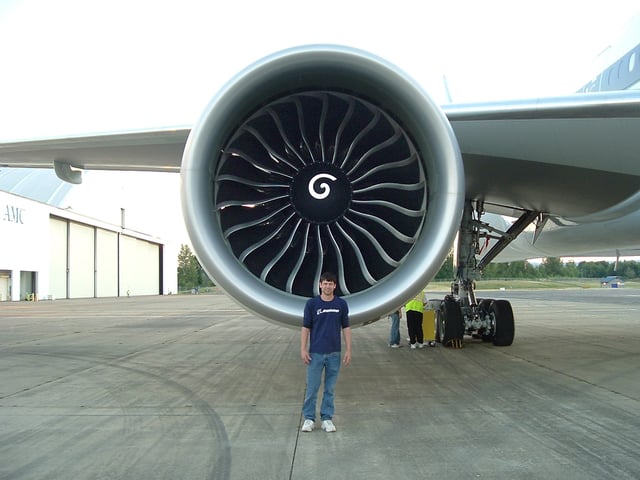
The more powerful GE90 engines of later variants has a 128 in (330 cm) diameter fan up from 123 in (310 cm) in earlier variants, and curved blades instead of straight ones
From the program's start, Boeing had considered building ultra-long-range variants.[97] Early plans centered on a 777-100X proposal,[98] a shortened variant of the -200 with reduced weight and increased range,[98] similar to the 747SP.[99] However, the -100X would have carried fewer passengers than the -200 while having similar operating costs, leading to a higher cost per seat.[98][99] By the late 1990s, design plans shifted to longer-range versions of existing models.[98] In March 1997, the Boeing board approved the 777-200X/300X specifications: 298 passengers in three classes over 8,600 nmi (15,900 km) for the 200X and 6,600 nmi (12,200 km) with 355 passengers in a tri-class layout for the 300X, with design freeze planned in May 1998, 200X certification in August 2000, and introduction in September and in January 2001 for the 300X.[100]
A more powerful engine in the thrust class of 100,000 lbf (440 kN) was required, leading to talks between Boeing and engine manufacturers. General Electric offered to develop the GE90-115B engine,[63] while Rolls-Royce proposed developing the Trent 8104 engine.[101] In 1999, Boeing announced an agreement with General Electric, beating out rival proposals.[63] Under the deal with General Electric, Boeing agreed to only offer GE90 engines on new 777 versions.[63]
On February 29, 2000, Boeing launched its next-generation twinjet program,[102] initially called 777-X,[97] and began issuing offers to airlines.[90] Development was slowed by an industry downturn during the early 2000s.[92] The first model to emerge from the program, the 777-300ER, was launched with an order for ten aircraft from Air France,[103] along with additional commitments.[90] On February 24, 2003, the -300ER made its first flight, and the FAA and EASA (European Aviation Safety Agency, successor to the JAA) certified the model on March 16, 2004.[104] The first delivery to Air France took place on April 29, 2004.[92] The -300ER, which combined the -300's added capacity with the -200ER's range, became the top-selling 777 variant in the late 2000s,[105] benefitting as airlines replaced comparable four-engine models with twinjets for their lower operating costs.[106]
The second long-range model, the 777-200LR, rolled out on February 15, 2005, and completed its first flight on March 8, 2005.[92] The -200LR was certified by both the FAA and EASA on February 2, 2006,[107] and the first delivery to Pakistan International Airlines occurred on February 26, 2006.[108] On November 10, 2005, the first -200LR set a record for the longest non-stop flight of a passenger airliner by flying 11,664 nautical miles (21,602 km) eastward from Hong Kong to London.[22] Lasting 22 hours and 42 minutes, the flight surpassed the -200LR's standard design range and was logged in the Guinness World Records.[21]
The production freighter model, the 777F, rolled out on May 23, 2008.[109] The maiden flight of the 777F, which used the structural design and engine specifications of the -200LR[110] along with fuel tanks derived from the -300ER, occurred on July 14, 2008.[111] FAA and EASA type certification for the freighter was received on February 6, 2009,[112] and the first delivery to launch customer Air France took place on February 19, 2009.[113][114]
Production developments and 777X
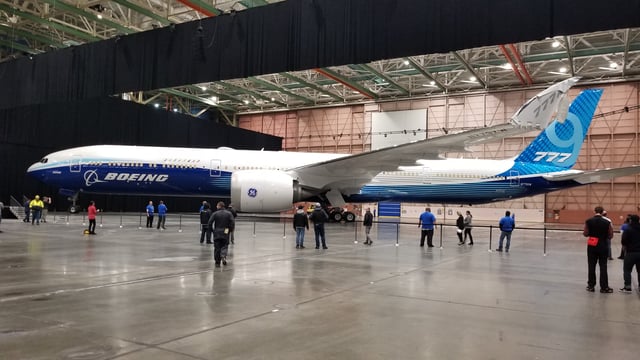
The Boeing 777X-9 was rolled out on March 13, 2019
Initially second to the 747 as Boeing's most profitable jetliner,[115] the 777 became the company's most lucrative model in the 2000s.[116] Program sales accounted for an estimated US$400 million of Boeing's pretax earnings in 2000, US$50 million more than the 747.[115] By 2004, the airliner accounted for the bulk of wide-body revenues for the Boeing Commercial Airplanes division.[117] In 2007, orders for second-generation 777 models approached 350 aircraft,[118] and in November of that year, Boeing announced that all production slots were sold out to 2012.[106] The program backlog of 356 orders was valued at US$95 billion at list prices in 2008.[119]
In 2010, Boeing announced plans to increase production from 5 aircraft per month to 7 aircraft per month by mid-2011, and 8.3 per month by early 2013.[120] Complete assembly of each 777-300ER requires 49 days.[121] The smaller Boeing 787 Dreamliner, the first stage of a replacement aircraft initiative called the Boeing Yellowstone Project,[122] entered service in 2011. Reportedly, the 777 could eventually be replaced by a new aircraft family, Yellowstone 3, which would draw upon technologies from the 787.[118] In November 2011, assembly began on the 1,000th 777, a -300ER model for Emirates,[121] which was rolled out in March 2012.[123]
By the late 2000s, the 777 was facing increased potential competition from Airbus' planned A350 XWB and internally from proposed 787 variants,[118] both airliners that offer fuel efficiency improvements. As a consequence, the 777-300ER received an engine and aerodynamics improvement package for reduced drag and weight.[124] In 2010, the variant further received a 5,000 lb (2,300 kg) maximum zero-fuel weight increase, equivalent to a higher payload of 20–25 passengers; its GE90-115B1 engines received a 1–2.5 percent thrust enhancement for increased takeoff weights at higher-altitude airports.[124] More changes were targeted for late 2012, including possible extension of the wingspan,[124] along with other major changes, including a composite wing, new powerplant, and different fuselage lengths.[124][125][126] Emirates was reportedly working closely with Boeing on the project, in conjunction with being a potential launch customer for new 777 versions.[127] Among customers for the aircraft during this period, China Airlines ordered ten 777-300ER aircraft to replace 747-400s on long-haul transpacific routes (with the first of those aircraft entering service in 2015), noting that the 777-300ER's per seat cost is about 20% lower than the 747's costs (varying due to fuel prices).[128]
In November 2013, with orders and commitments totaling 259 aircraft from Lufthansa, Emirates, Qatar Airways, and Etihad Airways, Boeing formally launched the 777X program, the third generation of the 777 (not to be confused with the 777-X variants, which were the second generation of the aircraft), with two models: the 777-8 and 777-9.[129] The 777-9 was to be a further stretched variant with a capacity of over 400 passengers and a range of over 15,200 km (8,200 nmi), whereas the 777-8 was slated to seat approximately 350 passengers and have a range of over 17,200 km (9,300 nmi).[129] Both models were to be equipped with new generation GE9X engines and feature new composite wings with folding wingtips. The first member of the 777X family, the 777-9, was set to enter service by 2020. By the mid-2010s, the 777 had become prevalent on the longest flights internationally and had become the most widely-used airliner for transpacific routes, with variants of the type operating over half of all scheduled flights and with the majority of transpacific carriers.[130][131]
By April 2014, with cumulative sales surpassing those of the 747, the 777 became the best-selling wide-body airliner; at existing production rates, the aircraft was on track to become the most-delivered wide-body airliner by mid-2016.[132] As of February 2015, the backlog of undelivered 777s totaled 278 aircraft, representing just under three years of current production at 8.3 aircraft per month,[133] causing Boeing to ponder the 2018-2020 time frame. In January 2016, Boeing confirmed plans to reduce the production rate of the 777 family from 8.3 per month to 7 per month in 2017 to help close the production gap between the 777 and 777X created by a lack of new orders.[134] In 2018, assembling test 777-9 aircraft was expected to lower output to an effective rate of 5.5 per month.[135] Boeing was expected to drop 777 production to five per month in August 2017.[136]
Updates and improvements
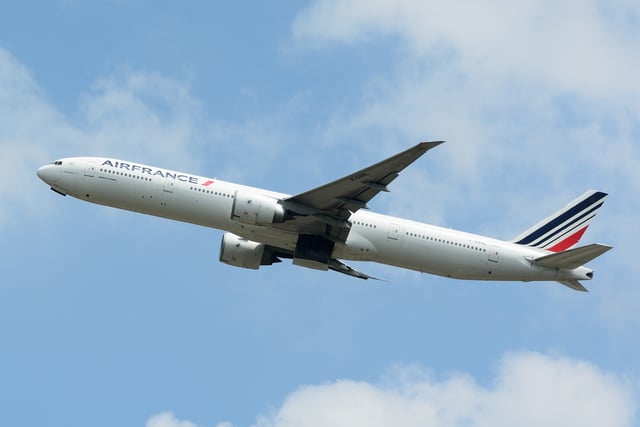
Air France received the first 777-300ER on April 29, 2004
In tandem with the development of the third generation 777X, Boeing worked with General Electric to offer a 2% improvement in fuel efficiency to in-production 777-300ER aircraft. General Electric improved the fan module and the high-pressure compressor stage-1 blisk in the GE-90-115 turbofan, as well as reduced clearances between the tips of the turbine blades and the shroud during cruise. These improvements, of which the latter is the most important and was derived from work to develop the 787, were stated by GE to lower fuel burn by 0.5%. Boeing's wing modifications were intended to deliver the remainder. Boeing stated that every 1% improvement in the 777-300ER's fuel burn translates into being able to fly the aircraft another 75 nmi (139 km; 86 mi) on the same load of fuel, or add ten passengers or 2,400 lb (1,100 kg) of cargo to a "load limited" flight.[137]
In March 2015, additional details of the improvement package were unveiled. The 777-300ER was to shed 1,800 lb (820 kg) by replacing the fuselage crown with tie rods and composite integration panels, similar to those used on the 787. New flight control software was to eliminate the need for the tail skid by keeping the tail off the runway surface regardless of the extent to which pilots command the elevators. Boeing was also redesigning the inboard flap fairings to reduce drag by reducing pressure on the underside of the wing. The outboard raked wingtip was to have a divergent trailing edge, described as a "poor man's airfoil" by Boeing; this was originally developed for the McDonnell Douglas MD-12 project. Another change involved elevator trim bias. These changes were to increase fuel efficiency and allow airlines to add 14 additional seats to the airplane, increasing per seat fuel efficiency by 5%.[138]
Mindful of the long time required to bring the 777X to the market, Boeing continued to develop improvement packages which improve fuel efficiency, as well as lower prices for the existing product. In January 2015, United Airlines ordered ten 777-300ERs, normally costing around US$150 million each but paid around US$130 million, a discount to bridge the production gap to the 777X.[139] The roll-out of the prototype 777X, a 777-9 model, occurred on March 13, 2019.[140]
As of 2019, Boeing lists prices for the 777-200ER, -200LR, 777F, -300ER, 777-8, and 777-9 variants. The -200ER is the only Classic variant remaining available.[15]
Design

Engines and extended slats, flaps, and landing gear of an American Airlines 777-200ER.
Boeing introduced a number of advanced technologies with the 777 design, including fully digital fly-by-wire controls,[141] fully software-configurable avionics, Honeywell LCD glass cockpit flight displays,[142] and the first use of a fiber optic avionics network on a commercial airliner.[143] Boeing made use of work done on the cancelled Boeing 7J7 regional jet,[144] which utilized similar versions of the chosen technologies.[144] In 2003, Boeing began offering the option of cockpit electronic flight bag computer displays.[145] In 2013, Boeing announced that the upgraded 777X models would incorporate airframe, systems, and interior technologies from the 787.[146]
Fly-by-wire
In designing the 777 as its first fly-by-wire commercial aircraft, Boeing decided to retain conventional control yokes rather than change to sidestick controllers as used in many fly-by-wire fighter aircraft and in many Airbus airliners.[141] Along with traditional yoke and rudder controls, the cockpit features a simplified layout that retains similarities to previous Boeing models.[147] The fly-by-wire system also incorporates flight envelope protection, a system that guides pilot inputs within a computer-calculated framework of operating parameters, acting to prevent stalls, overspeeds, and excessively stressful maneuvers.[141] This system can be overridden by the pilot if deemed necessary.[141] The fly-by-wire system is supplemented by mechanical backup.[148]
Airframe and systems
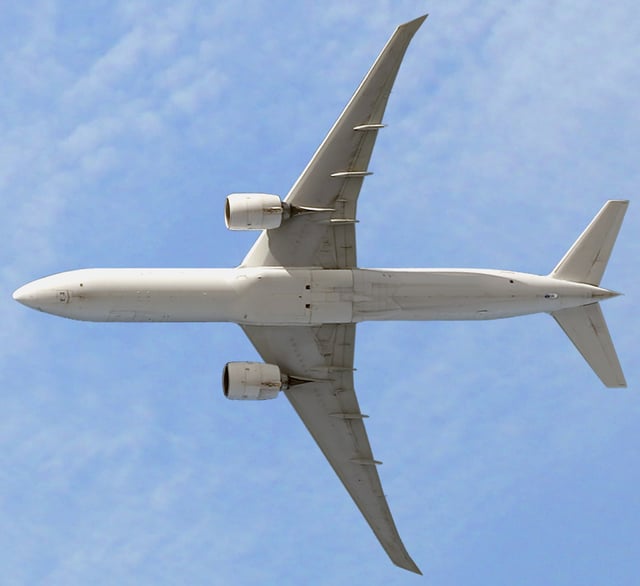
Planform view of a Boeing 777-300ER, with raked wingtips
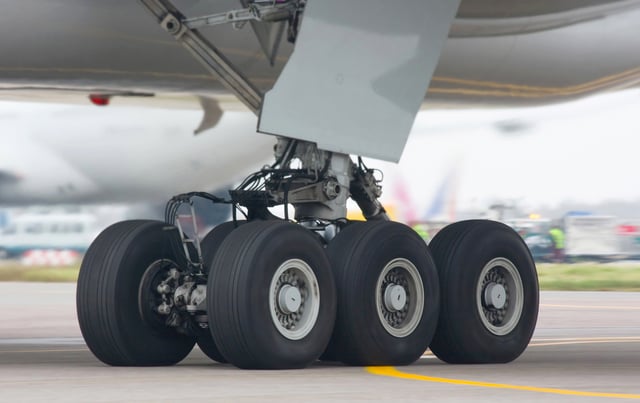
The six-wheel undercarriage of a Boeing 777
The wings on the 777 feature a supercritical airfoil design that is swept back at 31.6 degrees and optimized for cruising at Mach 0.83 (revised after flight tests up to Mach 0.84).[149] The wings are designed with increased thickness and a longer span than previous airliners, resulting in greater payload and range, improved takeoff performance, and a higher cruising altitude.[68] The wings also serve as fuel storage, with longer-range models able to carry up to 47,890 US gallons (181,300 L) of fuel.[150] This capacity allows the 777-200LR to operate ultra-long-distance, trans-polar routes such as Toronto to Hong Kong.[151] In 2013, a new wing made of composite materials was introduced for the upgraded 777X, with a wider span and design features based on the 787's wings.[146]
Unlike smaller airliners like the Boeing 737, no current 777 wings have winglets; instead, the exceptionally long raked wings of the 777 serve the same drag-reducing function. Large folding wingtips, 21 feet (6.40 m) long, were offered when the 777 was first launched, to appeal to airlines who might use gates made to accommodate smaller aircraft, but no airline purchased this option.[152] Folding wingtips reemerged as a design feature at the announcement of the upgraded 777X in 2013. Smaller folding wingtips of 11 feet (3.35 m) in length will allow 777X models to use the same airport gates and taxiways as earlier 777s.[146] These smaller folding wingtips are less complex than those proposed for earlier 777s, and internally only affect the wiring needed for wingtip lights.[146]
The airframe incorporates the use of composite materials, which comprise nine percent of its original structural weight (all models outside the 777-8 and 777-9).[153] Elements made from composite material include the cabin floor and rudder. The main fuselage cross-section is circular[154] and tapers rearward into a blade-shaped tail cone with a port-facing auxiliary power unit.[19] The aircraft also features the largest landing gear and the biggest tires ever used in a commercial jetliner.[155] The six-wheel bogies are designed to spread the load of the aircraft over a wide area without requiring an additional centerline gear. This helps reduce weight and simplifies the aircraft's braking and hydraulic systems. Each tire of a 777-300ER six-wheel main landing gear can carry a load of 59,490 lb (26,980 kg), which is heavier than other wide-bodies such as the 747-400.[156] The aircraft has triple redundant hydraulic systems with only one system required for landing.[157] A ram air turbine—a small retractable device which can provide emergency power—is also fitted in the wing root fairing.[158]
Interior
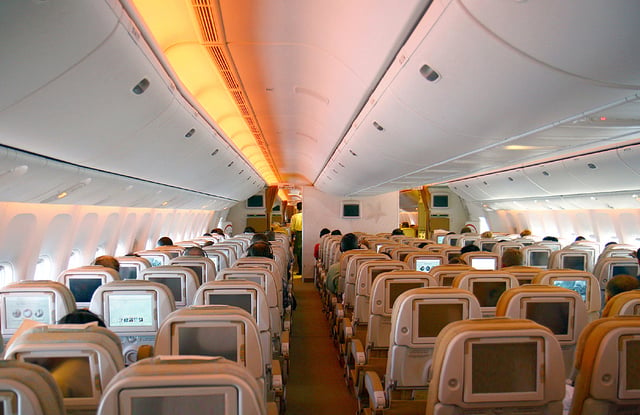
Economy class cabin of an Etihad Airways 777-300ER in a 3–3–3 layout.
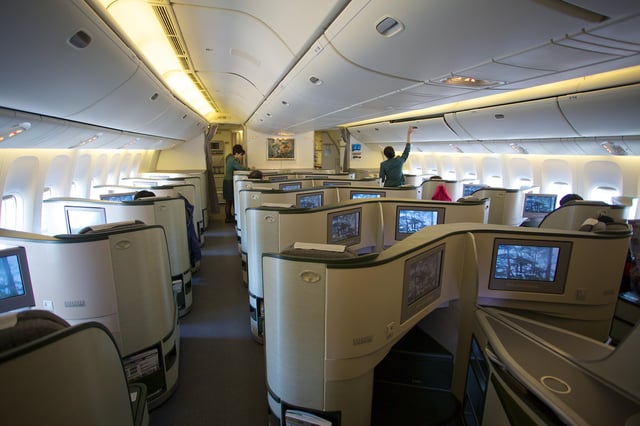
Business class in a 1-2-1 reverse herringbone layout on an EVA Air 777-300ER
The original 777 interior, also known as the Boeing Signature Interior, features curved panels, larger overhead bins, and indirect lighting.[81] Seating options range from four[159] to six abreast in first class up to ten abreast in economy.[160] The 777's windows were the largest of any current commercial airliner until the 787, and measure 15-inch (380 mm) by 10-inch (250 mm) in size (all models outside the 777-8 and -9).[161] The cabin also features "Flexibility Zones", which entails deliberate placement of water, electrical, pneumatic, and other connection points throughout the interior space, allowing airlines to move seats, galleys, and lavatories quickly and more easily when adjusting cabin arrangements.[160] Several aircraft have also been fitted with VIP interiors for non-airline use.[162] Boeing designed a hydraulically damped toilet seat cover hinge that closes slowly.[163]
In 2003, Boeing introduced overhead crew rests as an option on the 777.[164] Located above the main cabin and connected via staircases, the forward flight crew rest contains two seats and two bunks, while the aft cabin crew rest features multiple bunks.[164] The Signature Interior has since been adapted for other Boeing wide-body and narrow-body aircraft, including 737NG, 747-400, 757-300, and newer 767 models, including all 767-400ER models.[165][166] The 747-8 and 767-400ER have also adopted the larger, more rounded windows of the original 777.
In 2011, Flight International reported that Boeing is considering replacing the Signature Interior on the 777 with a new interior similar to that on the 787, as part of a move towards a "common cabin experience" across all Boeing platforms.[167] With the launch of the 777X in 2013, Boeing confirmed that the aircraft would be receiving a new interior featuring 787 cabin elements and larger windows.[146] Further details released in 2014 included re-sculpted cabin sidewalls for greater interior room, noise-dampening technology, and higher cabin humidity.[168]
Variants
Boeing uses two characteristics – fuselage length and range – to define its 777 models.[33] Passengers and cargo capacity varies by fuselage length: the 777-300 stretched the base 777-200 in 1998. Three range categories were defined: the A-market would cover domestic and regional operations, the B-market would cover routes from Europe to the US West coast and the C-market the longest transpacific routes.[169] The A-market would be covered by a 4,200 nmi (7,800 km) range, 234 t (516,000 lb) MTOW aircraft for 353 to 374 passengers powered by 316 kN (71,000 lbf) engines, followed by a 6,600 nmi (12,200 km) B-market range for 286 passengers in three-class, with 365 kN (82,000 lbf) unit thrust and 263 t (580,000 lb) of MTOW, an A340 competitor, basis of an A-market 409 to 434 passengers stretch, and eventually a 7,600 nmi (14,000 km) C-market with 400 kN (90,000 lbf) engines.[170]
When referring to different variants, the International Air Transport Association (IATA) code collapses the 777 model designator and the -200 or -300 variant designator to "772" or "773".[171] The International Civil Aviation Organization (ICAO) aircraft type designator system adds a preceding manufacturer letter for "B772" or "B773".[172] Designations may append a range identifier like "B77W" for the 777-300ER by the ICAO,[172] "77W" for the IATA,[171] though the -200ER is a company marketing designation and not certificated as such. Other notations include "773ER"[173] and "773B" for the -300ER.[174]
777-200
The initial 777-200 made its maiden flight on June 12, 1994 and was first delivered to United Airlines on May 15, 1995.[92] With a 545,000 lb (247,200 kg) MTOW and 77,000 lbf (340 kN) engines, it has a range of 5,240 nautical miles (9,700 km) with 305 passengers in a three-class configuration.[175] The -200 was primarily aimed at U.S. domestic airlines,[33] although several Asian carriers and British Airways have also operated the type. Nine different -200 customers have taken delivery of 88 aircraft,[12] with 55 in airline service as of July 2018.[24] The competing Airbus aircraft was the A330-300.[176]
In 2016, United Airlines shifted operations with all 19 of its -200s to exclusively domestic U.S. routes, including flights to and from Hawaii, and added more economy class seats by shifting to a ten-abreast configuration (a pattern that matched American Airlines’ reconfiguration of the type).[177][178] As of 2019, Boeing no longer markets the -200, as indicated by its removal from the manufacturer's price listings for 777 variants.[15]
777-200ER
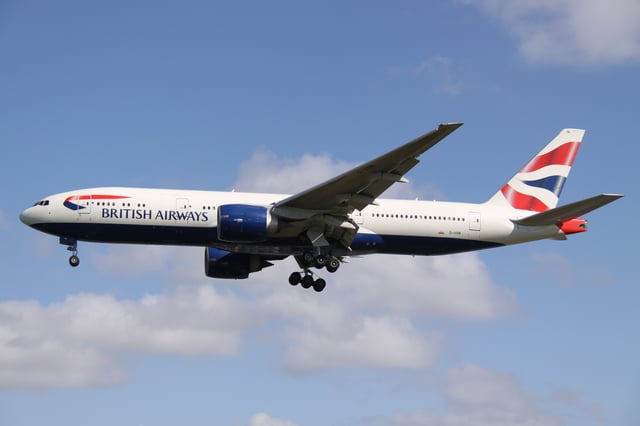
A 777-200ER of British Airways, its launch operator.
The B-market 777-200ER ("ER" for Extended Range), originally known as the 777-200IGW (increased gross weight), has additional fuel capacity and an increased MTOW for transatlantic routes.[91] With a 658,000 lb (298.46 t) MTOW and 93,700 lbf (417 kN) engines, it has a 7,065 nmi (13,084 km) range.[179] It was delivered first to British Airways on February 6, 1997.[92] Thirty-three customers received 422 deliveries, with no unfilled orders as of April 2019.[12]
As of July 2018, 338 examples of the -200ER are in airline service.[24] It competed with the A340-300.[180] Boeing proposes the 787-10 to replace it.[181] The value of a new -200ER rose from US$110 million at service entry to US$130 million in 2007; a 2007 model 777 was selling for US$30 million ten years later, while the oldest ones had a value around US$5–6 million, depending on the remaining engine time.[182]
777-200LR
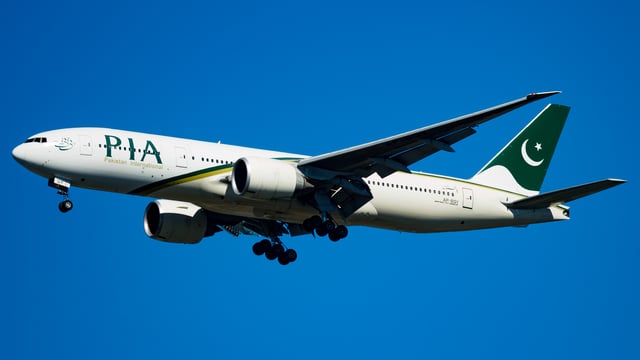
A Boeing 777-200LR in the colors of its first operator, Pakistan International Airlines.
The 777-200LR ("LR" for Longer Range), the C-market model, entered service in 2006 as one of the longest-range commercial airliners.[188][189] Boeing named it Worldliner as it can connect almost any two airports in the world,[22] although it is subject to ETOPS restrictions.[190] It holds the world record for the longest nonstop flight by a commercial airliner.[22] It has a maximum design range of 8,555 nautical miles (15,844 km) as of 2017.[179] The -200LR was intended for ultra long-haul routes such as Los Angeles to Singapore.[97]
Developed alongside the -300ER, the -200LR features an increased MTOW and three optional auxiliary fuel tanks in the rear cargo hold.[188] Other new features include extended raked wingtips, redesigned main landing gear, and additional structural strengthening.[188] As with the -300ER and 777F, the -200LR is equipped with wingtip extensions of 12.8 ft (3.90 m).[188] The -200LR is powered by GE90-110B1 or GE90-115B turbofans.[191] The first -200LR was delivered to Pakistan International Airlines on February 26, 2006.[108][192] Eleven different -200LR customers took delivery of 59 aircraft, with one unfilled order.[12] Airlines operated 50 of the -200LR variant as of July 2018.[24] Delta Air Lines and Emirates are the largest operators of the LR variant with each operating 10 aircraft.[193] The closest competing aircraft from Airbus are the discontinued A340-500HGW[188] and the A350-900ULR.[194]
777-300
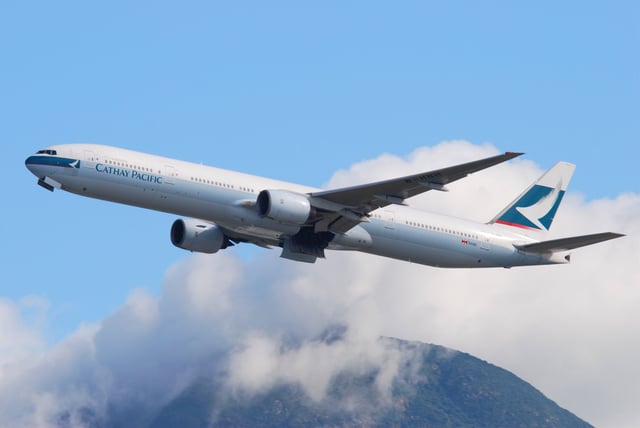
A 777-300 of Cathay Pacific, its launch operator.
Launched at the Paris Air Show on June 26, 1995, its major assembly started in March 1997 and its body was joined on July 21, it was rolled-out on September 8 and made its first flight on October 16. The 777 was designed to be stretched by 20%: 60 extra seats to almost 370 in tri-class, 75 more to 451 in two classes, or up to 550 in all-economy like the 747SR short-range variant. The 33 ft (10.1 m) stretch is done with 17 ft (5.3 m) in ten frames forward and 16 ft (4.8 m) in nine frames aft for a 242 ft (73.8 m) length, 11 ft (3.4 m) longer than the 747-400. It uses the -200IGW 45,200 US gal (171,200 L) fuel capacity and 84,000–98,000 lbf (374–436 kN) engines with a 580,000 to 661,000 lb (263.3 to 299.6 t) MTOW.[195]
It has ground maneuvering cameras for taxiing and a tailskid to rotate, while the proposed 716,000 lb (324.6 t) MTOW -300X would have needed a semi-levered main gear. Its overwing fuselage section 44 was strengthened, with its skin thickness going from the -200's 6.3 to 11.4 mm (0.25 to 0.45 in), and received a new evacuation door pair. Its operating empty weight with Rolls-Royce engines in typical tri-class layout is 343,300 lb (155.72 t) compared to 307,300 lb (139.38 t) for a similarly configured -200. Boeing wanted to deliver 170 -300s by 2006 and to produce 28 per year by 2002, to replace Boeing 747 Classics, burning one-third less fuel with 40% lower maintenance costs.[195]
With a 660,000 lb (299,370 kg) MTOW and 90,000 lbf (400 kN) engines, it has a range of 6,005 nautical miles (11,121 km) with 368 passengers in three-class.[175] Eight different customers have taken delivery of 60 aircraft of the variant, of which 18 were powered by the PW4000 and 42 by the RR Trent (none were ordered with the GE90, which was never certificated on this variant[196]),[12] with 48 in airline service as of July 2018.[24] The last -300 was delivered in 2006 while the longer-range -300ER started deliveries in 2004.[12]
777-300ER
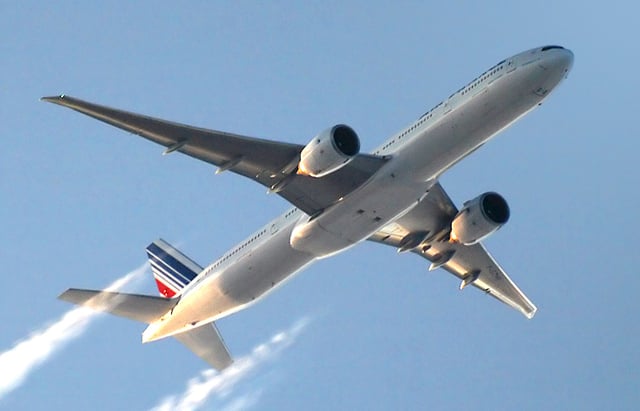
A 777-300ER in livery of Air France, its launch operator.
The 777-300ER ("ER" for Extended Range) is the B-market version of the -300. Its higher MTOW and increased fuel capacity permits a maximum range of 7,370 nautical miles (13,650 km) with 396 passengers in a two-class seating arrangement.[179] The 777-300ER features raked and extended wingtips, a strengthened fuselage and wings and a modified main landing gear.[197] Its wings have an aspect ratio of 9.0.[198] It is powered by the GE90-115B turbofan, the world's most powerful jet engine with a maximum thrust of 115,300 lbf (513 kN).[199] Following flight testing, aerodynamic refinements have reduced fuel burn by an additional 1.4%.[105][200] At Mach 0.839 (495 kn; 916 km/h), FL300, -59 °C and at a 513,400 lb (232.9 t) weight, it burns 17,300 lb (7.8 t) of fuel per hour. Its operating empty weight is 371,600 lb (168.6 t).[201]
Since its launch, the -300ER has been a primary driver of the twinjet's sales past the rival A330/340 series.[23] Its direct competitors have included the Airbus A340-600 and the A350-1000.[118] Using two engines produces a typical operating cost advantage of around 8–9% for the -300ER over the A340-600.[202] Several airlines have acquired the -300ER as a 747-400 replacement amid rising fuel prices given its 20% fuel burn advantage.[106] The -300ER has an operating cost of US$44 per seat hour, compared to an Airbus A380's roughly US$50 per seat hour (hourly cost is about US$26,000), and US$90 per seat hour for a Boeing 747-400 as of November 2015.[203]
The first -300ER was delivered to Air France on April 29, 2004.[204] The -300ER is the best-selling 777 variant, having surpassed the -200ER in orders in 2010 and deliveries in 2013.[12] As of July 2018, 784 -300ER aircraft were in service.[24] As of July 2019, -300ER deliveries to 45 different customers totalled 809, with 35 unfilled orders.[12] At its peak, a new 777-300ER was valued US$170 million, falling to US$150 million in 2019.[205]
In July 2018, Boeing was studying a 777-300ER freighter conversion, targeted for the volumetric market instead of the density market served by the 777F. After having considered a -200ER P2F program, Boeing hopes to conclude its study by fall as the 777X replacing aging -300ERs from 2020 will generate feedstock.[206] New-build 777-300ER freighters may maintain the delivery rate at five per month, to bridge the production gap until the 777X is delivered.[207]
777 Freighter
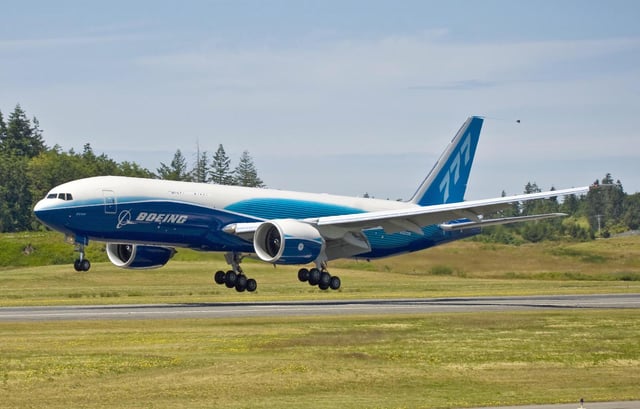
The first 777F in Boeing livery during a test flight.
The 777 Freighter (777F) is an all-cargo version of the twinjet, and shares features with the -200LR; these include its airframe, engines,[208] and fuel capacity.[150] With a maximum payload of 224,900 lb (102,000 kg) (similar to the 243,000 lb (110,000 kg) of the Boeing 747-200F), it has a range of 4,970 nmi (9,200 km).[179] Greater range is possible if less cargo weight is carried.[209]
As the aircraft promises improved operating economics compared to older freighters,[106] airlines have viewed the 777F as a replacement for freighters such as the Boeing 747-200F, McDonnell Douglas MD-10 and McDonnell Douglas MD-11F.[110][210] The first 777F was delivered to Air France on February 19, 2009.[113] As of July 2019, 168 freighters had been delivered to 23 different customers, with 59 unfilled orders.[12] Operators had 140 of the 777F in service as of July 2018.[24]
In the 2000s, Boeing began studying the conversion of 777-200ER and -200 passenger airliners into freighters, under the name 777 BCF (Boeing Converted Freighter).[211] The company has been in discussion with several airline customers, including FedEx Express, UPS Airlines, and GE Capital Aviation Services, to provide launch orders for a 777 BCF program.[212]
777X
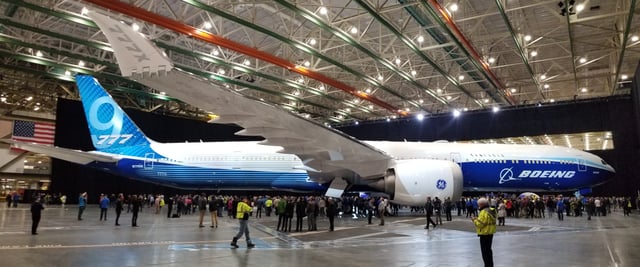
Unveiling of the first 777-9X on March 13, 2019.
The 777X is to feature new GE9X engines, new composite wings with folding wingtips, it was launched in November 2013 with two variants: the 777-8 and the 777-9.[129] The 777-8 provides seating for 365 passengers and has a range of 8,690 nmi (16,090 km), and the 777-9 has seating for 414 passengers and a range of over 7,525 nmi (13,936 km).[213] The -9 is expected to fly in 2020 with deliveries the same year.[214]
Government and corporate
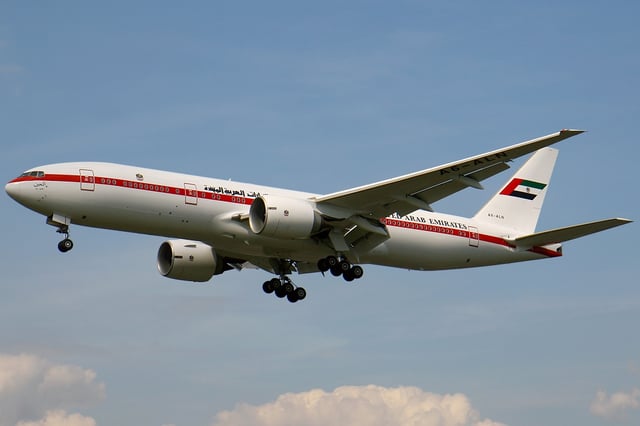
A Presidential Flight of United Arab Emirates government 777-200ER.
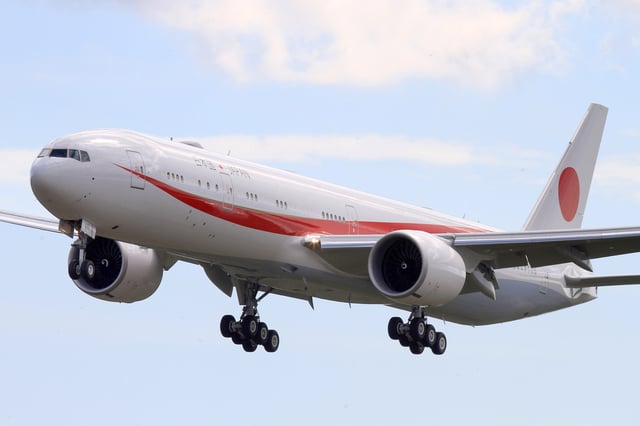
A Japan Air Self-Defense Force 777-300ER operating as Japanese Air Force One.
Versions of the 777 have been acquired by government and private customers. The main purpose has been for VIP transport, including as an air transport for heads of state, although the aircraft has also been proposed for other military applications.
777 Business Jet (777 VIP) – the Boeing Business Jet version of the 777 that is sold to corporate customers. Boeing has received orders for 777 VIP aircraft based on the 777-200LR and 777-300ER passenger models.[215][216] The aircraft are fitted with private jet cabins by third party contractors,[215] and completion may take 3 years.[217]
777 Tanker (KC-777) – the KC-777 is a proposed tanker version of the 777. In September 2006, Boeing announced that it would produce the KC-777 if the United States Air Force (USAF) required a larger tanker than the KC-767, able to transport more cargo or personnel.[218][219][220] In April 2007, Boeing offered its 767-based KC-767 Advanced Tanker instead of the KC-777 to replace the smaller Boeing KC-135 Stratotanker under the USAF's KC-X program.[221] Boeing officials have described the KC-777 as suitable for the related KC-Z program to replace the wide-body McDonnell Douglas KC-10 Extender.[222]
In 2014, the Japanese government chose to procure two 777-300ERs to serve as the official air transport for the Emperor of Japan and Prime Minister of Japan.[223] The aircraft, to be operated by the Japan Air Self-Defense Force under the callsign Japanese Air Force One, are scheduled to enter service in 2019 and replace two 747-400s. Besides VIP transport, the 777s are also intended for use in emergency relief missions.[223]
777s are serving or have served as official government transports for nations including Gabon (VIP-configured 777-200ER),[224] Turkmenistan (VIP-configured 777-200LR),[225] and the United Arab Emirates (VIP-configured 777-200ER and 777-300ER operated by Abu Dhabi Amiri Flight)[216] Prior to returning to power as Prime Minister of Lebanon, Rafic Hariri acquired a 777-200ER as an official transport.[226] India's government is to use two Air India 777-300ERs for VVIP transport.[227][228]
In 2014, the USAF examined the possibility of adopting modified 777-300ERs or 777-9Xs to replace the Boeing 747-200 aircraft used as Air Force One.[229] Although the USAF had preferred a four–engine aircraft, this was mainly due to precedent (existing aircraft were purchased when the 767 was just beginning to prove itself with ETOPS; decades later, the 777 and other twin jets established a comparable level of performance as quad-jet aircraft).[229] Ultimately, the air force decided against the 777, and selected the Boeing 747-8 to become the next presidential aircraft.[230]
Operators
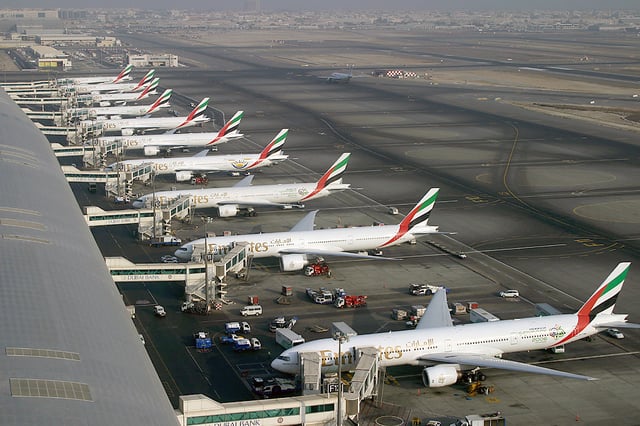
A row of Boeing 777-300s and -300ERs at Dubai International Airport operated by Emirates, the largest 777 customer.
Boeing customers that have received the most 777s are Emirates, Singapore Airlines, United Airlines, ILFC, and American Airlines.[12] Emirates is the largest airline operator as of July 2018,[24] and is the only customer to have operated all 777 variants produced, including the -200, -200ER, -200LR, -300, -300ER, and 777F.[12][231] The 1,000th 777 off the production line, a -300ER set to be Emirates' 102nd 777, was unveiled at a factory ceremony in March 2012.[123]
A total of 1,416 aircraft (all variants) were in airline service as of July 2018, with Emirates (163), United Airlines (91), Air France (70), Cathay Pacific (69), American Airlines (67), Qatar Airways (67), British Airways (58), Korean Air (53), All Nippon Airways (50), Singapore Airlines (46), and other operators with fewer aircraft of the type.[24]
In 2017, 777 Classics are reaching the end of their mainline service: with a -200 age ranging from three to 22 years, 43 Classic 777s or 7.5% of the fleet have been retired. Values of 777-200ERs have declined by 45% since January 2014, faster than Airbus A330s and Boeing 767s with 30%, due to the lack of a major secondary market but only a few budget, air charters and ACMI operators. In 2015, Richard H. Anderson, then Delta Air Lines' chairman and chief executive, said he had been offered 777-200s for less than US$10 million. To keep them cost efficient, operators densify their 777s for about US$10 million each, like Scoot with 402 seats in its dual-class -200s, or Cathay Pacific which switched the 3–3–3 economy layout of 777-300s to 3–4–3 to seat 396 on regional services.[20]
Orders and deliveries
The 777 surpassed 2,000 orders by the end of 2018.[232]
| Total orders | Total deliveries | |
| 777-200 | 88 | 88 |
| 777-200ER | 422 | 422 |
| 777-200LR | 61 | 59 |
| 777-300 | 60 | 60 |
| 777-300ER | 844 | 810 |
| 777F | 230 | 170 |
| 777X | 344 | – |
| Total | 2,049 | 1,609 |
Orders and deliveries through August 2019[12]
| 90−94 | 1995 | 1996 | 1997 | 1998 | 1999 | 2000 | 2001 | 2002 | 2003 | 2004 | 2005 | 2006 | 2007 | 2008 | 2009 | 2010 | 2011 | 2012 | 2013 | 2014 | 2015 | 2016 | 2017 | 2018 | 2019 | Total | ||
| Orders | 112 | 101 | 68 | 54 | 68 | 35 | 116 | 30 | 32 | 13 | 42 | 153 | 76 | 110 | 39 | 30 | 75 | 194 | 75 | 121 | 277 | 58 | 23 | 53 | 51 | 36 | 2,049 | |
| Deliveries | −200 | – | 13 | 32 | 11 | 10 | 3 | 9 | 3 | – | 1 | 2 | 3 | – | 1 | – | – | – | – | – | – | – | – | – | – | – | – | 88 |
| −200ER | – | – | – | 48 | 50 | 63 | 42 | 55 | 41 | 29 | 22 | 13 | 23 | 19 | 3 | 4 | 3 | – | 3 | 4 | – | – | – | – | – | – | 422 | |
| −200LR | – | – | – | – | – | – | – | – | – | – | – | – | 2 | 10 | 11 | 16 | 9 | 6 | 1 | 1 | 3 | – | – | – | – | – | 59 | |
| −300 | – | – | – | – | 14 | 17 | 4 | 3 | 6 | 9 | 2 | 4 | 1 | – | – | – | – | – | – | – | – | – | – | – | – | – | 60 | |
| −300ER | – | – | – | – | – | – | – | – | – | – | 10 | 20 | 39 | 53 | 47 | 52 | 40 | 52 | 60 | 79 | 83 | 79 | 88 | 65 | 32 | 11 | 810 | |
| 777F | – | – | – | – | – | – | – | – | – | – | – | – | – | – | – | 16 | 22 | 15 | 19 | 14 | 13 | 19 | 11 | 9 | 16 | 16 | 170 | |
| 777X | – | – | – | – | – | – | – | – | – | – | – | – | – | – | – | – | – | – | – | – | – | – | – | – | – | – | – | |
| All | – | 13 | 32 | 59 | 74 | 83 | 55 | 61 | 47 | 39 | 36 | 40 | 65 | 83 | 61 | 88 | 74 | 73 | 83 | 98 | 99 | 98 | 99 | 74 | 48 | 27 | 1,609 | |
Boeing 777 orders and deliveries (cumulative, by year):
Orders
Deliveries
Aircraft on display
The first prototype Boeing 777-200, N7771, was retired in mid-2018 amid press reports that it was to be displayed at the Museum of Flight in Seattle, although these reports were subsequently denied by the museum.[233] On September 18, 2018, Cathay Pacific and Boeing announced that N7771 would be donated to the Pima Air & Space Museum near Tucson, Arizona, where it would be placed on permanent display.[234] This aircraft, which had previously been in regular use by Cathay Pacific between 2000 and 2018, was manufactured in 1994 and was delivered to the airline after spending six years with Boeing.[235][236]
Accidents and incidents

Laboratory replication of ice crystals clogging the fuel-oil heat exchanger on a Rolls-Royce Trent 800 engine, from the Air Accidents Investigation Branch (AAIB) report on the British Airways Flight 38 (BA38) and Delta Air Lines Flight 18 (DL18) incidents.[237]
As of February 2019, the 777 has been involved in 28 aviation accidents and incidents,[238] including a total of seven hull-losses (five in-flight and two in ground incidents) resulting in 541 fatalities along with three hijackings.[239][240] The first fatality involving the twinjet occurred in a fire while an aircraft was being refueled at Denver International Airport in the United States on September 5, 2001, during which a ground worker sustained fatal burns.[241] The aircraft, operated by British Airways, suffered fire damage to the lower wing panels and engine housing; it was later repaired and returned to service.[241][242]
The type's first hull-loss occurred on January 17, 2008, when a 777-200ER with Rolls-Royce Trent 895 engines, flying from Beijing to London as British Airways Flight 38, crash-landed approximately 1,000 feet (300 m) short of Heathrow Airport's runway 27L and slid onto the runway's threshold. There were 47 injuries and no fatalities. The impact severely damaged the landing gear, wing roots and engines.[243][244] The accident was attributed to ice crystals suspended in the aircraft's fuel clogging the fuel-oil heat exchanger (FOHE).[237][245] Two other minor momentary losses of thrust with Trent 895 engines occurred later in 2008.[246][247] Investigators found these were also caused by ice in the fuel clogging the FOHE. As a result, the heat exchanger was redesigned.[237][248]
The type's second hull-loss occurred on July 29, 2011 when a 777-200ER scheduled to operate as EgyptAir Flight 667 suffered a cockpit fire while parked at the gate at Cairo International Airport before its departure.[249] The aircraft was evacuated with no injuries,[249] and airport fire teams extinguished the fire.[250] The aircraft sustained structural-, heat- and smoke damage, and was written off.[249][250] Investigators focused on a possible short circuit between an electrical cable and a supply hose in the cockpit crew oxygen system.[249]
The type's third hull-loss occurred on July 6, 2013 when a 777-200ER, operating as Asiana Airlines Flight 214, crashed while landing at San Francisco International Airport after touching down short of the runway. The 307 surviving passengers and crew on board evacuated before fire destroyed the aircraft. Two passengers, who had not been wearing their seatbelts, were ejected from the aircraft during the crash and were killed.[251] A third passenger died six days later as a result of injuries sustained during the crash.[252] These were the first fatalities in a crash involving a 777 since its entry into service in 1995.[253][252][254] The official accident investigation concluded in June 2014 that the pilots committed 20 to 30 minor to significant errors in their final approach, and that complexities of the automated controls contributed to the accident.[255][256]
The type's apparent fourth hull-loss occurred on March 8, 2014 when a 777-200ER carrying 227 passengers and 12 crew, en route from Kuala Lumpur to Beijing as Malaysia Airlines Flight 370, was reported missing. Air Traffic Control's last reported coordinates for the aircraft were over the South China Sea at 6°55′15″N 103°34′43″E [286] .[257][258] After the search for the aircraft began, Malaysia's prime minister announced on March 24, 2014 that after analysis of new satellite data it was now to be assumed "beyond reasonable doubt" that the aircraft had crashed in the Indian Ocean and there were no survivors.[259][260] The cause remains unknown, but the Malaysian Government declared it was an accident in January 2015.[261][262] On July 29, 2015, an item later identified as a flaperon strongly suspected to be from the missing aircraft was found on the island of Réunion in the western Indian Ocean.[263]
The type's fifth hull-loss occurred on July 17, 2014, when a 777-200ER, bound for Kuala Lumpur from Amsterdam as Malaysia Airlines Flight 17 (MH17), broke up in mid-air and crashed[264] in the Donetsk province in eastern Ukraine, after being hit by an anti-aircraft missile.[265] All 298 people (283 passengers and 15 crew) on board were killed, making this the deadliest crash involving the Boeing 777. The incident was linked to the ongoing Donbass insurgency in the region.[266][267] The official accident report, released in October 2015, states that airliner was brought down by a Buk missile launched from territory held by pro-Russian separatists.[268]
The sixth hull-loss of the type occurred on August 3, 2016, when a 777-300 crashed while landing and caught fire at Dubai Airport at the end of its flight as Emirates Flight 521.[269] The preliminary investigation indicated that the aircraft was attempting a landing during active wind shear conditions. The pilots initiated a go-around procedure shortly after the main wheels touched-down onto the runway, however, the aircraft settled back onto the ground apparently due to late throttle application. As the undercarriage was in the process of being retracted, the aircraft landed on its rear underbody and engine nacelles, resulting in the separation of one engine, loss of control and subsequent crash.[270] There were no passenger casualties of the 300 people on board, however, one airport fireman was killed fighting the fire. The aircraft's fuselage and right wing were irreparably damaged by the fire.[269][271]
The type's seventh hull-loss occurred on November 29, 2017, when a Singapore Airlines 777-200ER experienced a fire while being towed at Singapore Changi Airport. An aircraft technician was the only occupant on board and evacuated safely. The aircraft sustained heat damage and was written off.[272]
Other notable accidents and incidents include British Airways Flight 2276, a 777-200ER that aborted takeoff at Las Vegas McCarran International Airport on September 8, 2015 after a serious uncontained engine failure punctured 'multiple' holes in the engine case, with all crew and passengers evacuating with only minor injuries occurring;[273][274][275][276] Korean Air Flight 2708, a 777-300 that suffered a Number 1 Pratt & Whitney PW4000 engine fire prior to takeoff at Tokyo International Airport, with all aboard evacuating safely;[277][278][279] and Singapore Airlines Flight 368, a 777-300ER whose right engine and wing caught fire after an emergency landing at Singapore Changi Airport due to an oil leak in the right engine with no injuries.[280][281]
Specifications

Diagram of Boeing 777 variants with front, cross-section, side, and top views: 777-200ER on left, 777-300ER on right.
| Variants | Initial[191] | Long-range[150] | ||||||||||||||||||||||
|---|---|---|---|---|---|---|---|---|---|---|---|---|---|---|---|---|---|---|---|---|---|---|---|---|
| Model | 777-200/200ER | 777-300 | 777-300ER | 777-200LR/777F | ||||||||||||||||||||
| Crew | Two (cockpit) | |||||||||||||||||||||||
| 3-class seats[175] | 305 (24F/54J/227Y) | 368 (30F/84J/254Y) | 365 (22F/70J/273Y) | 301 (16F/58J/227Y) [2] | ||||||||||||||||||||
| 2-class seats[179] | 313 | 396 | 317 | |||||||||||||||||||||
| Exit limit[196] | 440 | 550 | 440 [3] | |||||||||||||||||||||
| Length | 209 ft 1 in / 63.73 m | 242 ft 4 in / 73.86 m | 209 ft 1 in / 63.73 m | |||||||||||||||||||||
| Wingspan | 199 ft 11 in / 60.93 m, 31.6° Wing sweep[282] | 212 ft 7 in / 64.80 m, 31.6° Wing sweep[282] | ||||||||||||||||||||||
| Wing area | 4,605 sq ft (427.8 m2),[282] 8.68 AR | 4,702 sq ft (436.8 m2),[283] 9.04 AR | ||||||||||||||||||||||
| Tail height[179] | 60 ft 9 in / 18.5 m | 60 ft 8 in / 18.5 m | 61 ft 1 in / 18.6 m | |||||||||||||||||||||
| Fuselage width | 20 ft 4 in / 6.20 m | |||||||||||||||||||||||
| Cabin width | 231 in / 5.86 m,[284] Seats: 18.5 in / 47 cm at 9 abreast, 17 in / 43 cm at 10 abreast | |||||||||||||||||||||||
| Cargo volume[179] | 5,330 ft³ / 150.9 m³ | 7,120 ft³ / 201.6 m³ | 5,330 ft³ / 150.9 m³ [4] | |||||||||||||||||||||
| MTOW | 545,000 lb / 247,200 kg 200ER: 656,000 lb / 297,550 kg | 660,000 lb / 299,370 kg | 775,000 lb / 351,533 kg | 766,000 lb / 347,452 kg 777F: 766,800 lb / 347,815 kg | ||||||||||||||||||||
| OEW | 299,550 lb / 135,850 kg 200ER: 304,500 lb / 138,100 kg | 353,800 lb / 160,530 kg | 370,000 lb / 167,829 kg | 320,000 lb / 145,150 kg 777F: 318,300 lb / 144,379 kg | ||||||||||||||||||||
| Fuel capacity | 31,000 US gal / 117,340 L / 207,700 lb / 94,240 kg 200ER/300: 45,220 US gal / 171,171 L / 302,270 lb / 137,460 kg | 47,890 US gal / 181,283 L / 320,863 lb / 145,538 kg | ||||||||||||||||||||||
| Ceiling[196] | 43,100 ft (13,100 m) | |||||||||||||||||||||||
| Speed | Max. Mach 0.87–Mach 0.89 (499–511 kn; 924–945 km/h),[196] Cruise Mach 0.84 (482 kn; 892 km/h) | |||||||||||||||||||||||
| Range[179] | 5,240 nmi / 9,700 km[5][175] 200ER: 7,065 nmi / 13,080 km[6] | 6,030 nmi / 11,165 km[7][175] | 7,370 nmi / 13,649 km[8] | 8,555 nmi / 15,843 km[9] 777F: 4,970 nmi / 9,200 km[10] | ||||||||||||||||||||
| Takeoff[11] | 8,000 ft (2,440 m) 200ER:11,100 ft (3,380 m) | 10,600 ft (3,230 m) | 10,000 ft (3,050 m) | 9,200 ft (2,800 m) 777F: 9,300 ft (2,830 m) | ||||||||||||||||||||
| Turbofan | 2× PW4000 / Trent 800 / GE90 | 2× PW4000 / Trent 800[196] | 2× GE90-110B1/115B | |||||||||||||||||||||
| Max thrust | 2× 77,200 lbf (343 kN) 200ER: 2× 93,700 lbf (417 kN) | 2× 98,000 lbf (440 kN) | 2× 115,300 lbf (513 kN) | |||||||||||||||||||||
| ICAO designation[172] | B772 | B773 | B77W | B77L | ||||||||||||||||||||
See also
Competition between Airbus and Boeing
Related development
Boeing 7J7 – Proposed short to medium range airline that would have succeeded the 727
Boeing 777X – Next generation of the Boeing 777
Aircraft of comparable role, configuration and era
Airbus A330 – Wide-body twin-engine jet airliner A330neo – Wide-body jet airliner developed from Airbus A330
Airbus A340 – Four engine wide-body jet airliner
Airbus A350 XWB – Family of long-range, wide-body jet airliners made primarily of composite materials
Boeing 767 – Large wide-body twin-engine jet airliner family
Boeing 787 Dreamliner – Wide-body twin-engine jet airliner, first airliner to be constructed primarily of composite materials
Ilyushin Il-96 – Four-engined long-haul wide-body airliner
McDonnell Douglas MD-11 – Wide body airliners developed from the DC-10
Related lists
List of Boeing 777 operators
List of Boeing 777 orders and deliveries
List of Boeing customer codes
List of jet airliners
List of civil aircraft
